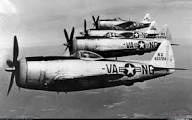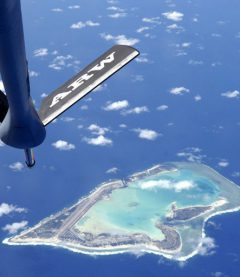t
Introduction
The P-47 Thunderbolt was a World War II fighter built in the United States by Republic Aircraft between 1941-1945. There were 15,636 P-47s built during this time.
It’s roles were fighter-bomber, ground attack, and high altitude escort for the United States Army Air Forces (USAAF). France, Britain, Russia, Mexico and Brazil also used the Thunderbolt during the War. The modern-day Fairchild-Republic A-10 is also called the Thunderbolt.
Design and Development
The P-47 was initially designed by Alexander Kartveli, a Russian immigrant who had escaped the Russian Bolsheviks, along with Alexander P. de Seversky another Russian immigrant went to work for Republic to help in designing the AP-4 demonstrator for United States Army Air Corp (USAAC)
The AP-4 was redesigned the P=43 Lancer to be used for bidding for a contract with USAAC. As with early models, improvement was always being sought and thus the P-44 Rocket came forth. At the same time a lighter version of the P-44 named the AP-10 were brought forth for USAAC.
Both aircraft were powered by the Allison liquid-cooled, in-line V-12 engine and armed with 50 cal M2 Browning machine guns. The USAAC liked both the P-44 and AP-10 and gave them the designation of XP-44 and XP-47. Thus, the start of the P-47 family.
As the war in Europe escalated in the Spring of 1940, both the USAAC and Republic concluded that both of the models were inferior to the Luftwaffe. Republic looked to improving the design of the XP-74A as the lighter model was designated, but Alexander Kartveli designed a much larger and heavier XP-47B.
The XP-47B was all-metal (exception was, the fabric covered tail control surfaces), new elliptical wings that had straight leading edge that was slightly swept back.
Some other features were a roomy, air-conditioned cockpit and self-sealing fuel tanks. The XP-47B was powered by Pratt and Whitney R-2800 Double Wasp two-row 18 cylinder radial engines producing 2,00 hp that turned a Curtis Electric constant-speed 4 bladed propeller, with each blade 146 in diameter.
It was designed for air cooling of the engine oil coolers and the turbocharger intercooler system. It’s armament were 8 Browning An/M2 machine guns with 4 in each wing. In 1942 the newly reorganized USAAC now called the United States Army Air Force (USAAFF) ordered 171
P-47Bs from Republic despite some “teething” problems. The P-47D was the most widely produced of all the P-47 models and versions, with over 12,500 built at the Long Island, New York and Evansville, Indiana plants. The “D” model looked the same as the “C” model, just some engine and fuselage changes, mostly interior not noticeable at sight except for some drop tank capabilities to increase the range of the aircraft.

Later versions received the “Bubble-top” canopy similar to the P-51D-Mustang added dive recovery flaps, modified the vertical stabilizer to counter yawing problems. Other models that were used for various were: XP-47H, XP-47J, P47M, P-47N.
The P-47N was the last model produced and was an escort for the B-29 Superfortress.bombers flying raids on the Japanese Islands in the Pacific. A total of 1,816 P-47N rolled of the assembly line that ended in October 1945.
Operational History
In 1942,the 56th Fighter Group consisting of P-47Cs was sent to England as the first contingency of American P-47s. The first mission wasn’t until 1943 as the first “jugs” had radio problem not being compatible with British communications. Thus the delay.
The term Jug was in reference to the “milk jugs” of the day as the aircraft looked a lot life one. The first air combat involving the Thunderbolt was 15 April 43, as Don Blakeslee scored a victory over a FW-190. Later in 1943, the 12th Air Force was supplied with P-47s.
The 348th Fighter Group in Port Modesty, New Guinea in the Pacific theater also was flying P-47s against the Japanese. Although the P-51 Mustang replaced the P-47 as the long bomber escort in Europe, the P-47 ended the war with 3,752 victories in over 746,00 missions.
When the “Jug” stated with the C model in Europe, the escort range was limited. As the war progressed, differed modifications served to lengthened the range of the P-47.
Then a typical mission with P-47 escort would consist of the Thunderbolts escorting the bombers to target and some P-47s would break away from the bomber group that they had escorted to target and search for ground targets of opportune.
First ejecting drop tanks, than diving towards their target with the “Holy Moses” M8 High Velocity rockets and sometimes 500 lb bombs or just plain strafing with 50 cal machine guns, the Thunderbolt pilots destroyed an estimated 86,00 rail cars, 9,000 locomotives, 6,000 armed fighting vehicles, and 68,000 trucks The P-47 became the USAAF’s best fighter/bomber of the war.
When World War II ended in 1945, the P-47 continued on with USAAF and than with the USAF (United States Air Force). They were not used in the Korean War as the Jet Age had come about.
The P-51 Mustang was selected by the military leaders to be used for close ground support. Many former Jug pilots felt the P-47 was more rugged and could sustain more damage than the Mustang, but the P-51 was more plentiful int USAF and USAF ANG unites during that time.

The P-47 was used by the British as a Ground Attack Fighter named the Thunderbolt Mark I and Mark II. At the time the British had enough long ranged escort (longer ranged than the P-47) but had a need for ground attack fighter both in Europe but also in the Pacific in the India-China-Burma theater. There they were used to strafe airfields , convoys (usually ground types) and concentrations of enemy troops.
Other P-47 models were purchased by Mexico, France* Italy*, China, Iran, Turkey in small numbers. *(after the war). The Soviets also purchased several hundred Thunderbolts but were used mostly for testing and reverse engineering.
All in all the Thunderbolt was a good performer, better at higher altitudes, had a good roll rate, climb was poor, and maneuverability was poor at low altitudes. It certainly contributed in a positive way to the Allies war effort.
Where you can see the Thunderbolt
Airworthy-P47D
Dottie Mae – Carswell Industrial Airport, Caldwell, Idaho
Balls Out – Lewis Air Legends, San Antonio Texas
Tarheel Hal –Lone Star Flight Museum, Galveston, Texas
Wickett Wabbitt –Aviation Management Resources–Wilmington Delaware
On Display
Big Stud-Museum of Flight, Seattle, Washington
Five by Five-National Museum of the Air Force at Wright-Patterson, Dayton Ohio
Checky Baby-Cardio of Aviation Museum, Garden City New York
Norma-New England Air Museum, Windsor Locks, Connectiut
There is an abundance of P-47s of all models on display. Check with your local Air Museum for more details
Tech Specs for the P-47 Thunderbolt
Wing Span: 40 ft 9 in
Length: 36 ft 1 in
Height: 14 ft 8 in
Weight: 10,000 lbs (empty) 12,731 lbs (MTOW)
Max Speed: 433 mph
Ceiling: 43,000 ft
Range: 800sm (combat); 1,800mi (ferry)
Engine: 1/Pratt & Whitney R-2800-59B twin row radial engine
Crew: 1
THANKS FOR READING! I HOPE THIS WAS INFORMATIVE!

